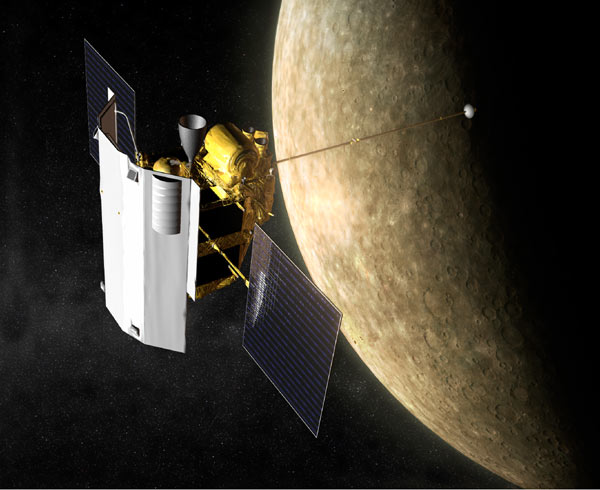
In a cosmicversion of laser tag, NASA's MESSENGERspacecraft and an Earth-based observatory successfully exchanged laser pulseswith each other while millions of miles apart.
The featsets a new record for laser transmission in space, a process which may one daybe used to communicate across interplanetary distances and provide scientistswith a powerful tool to measure the movement of planets and test fundamentalprinciples in physics.
MESSENGERwas launched in 2004 on a six-year voyage to Mercury.In late May of 2005, scientists used the spacecraft's Mercury Laser Altimeter(MLA), an instrument designed to map Mercury's surface, to exchange laserpulses with NASA's Goddard Geophysical and Astronomical Observatory in Maryland. MESSENGER was approximately 15 million miles (25 million km) away at the time.
Theexperiment, reported today, marks the first successful back-and-forth exchangeof laser signals between Earth and space. In 1992, laser pulses weresuccessfully transmitted from Earth and detected by a receiver aboard the Galileoprobe while it was about 4 million miles (6 million km), but the transmissionwas only one way since Galileo did not have a transmitter of its own.
Broadbandin space
Two-waylaser communication in space has long been a goal for NASA because it wouldenable data transmission rates that are 10 to 1,000 times higher than traditionalradio waves. While lasers and radio transmissions both travel at light-speed,lasers can pack more data. It's similar to moving from a dial-up Internetconnection to broadband.
"We've beentrying to do this kind of thing for about a decade," said David Smith, aresearcher from Goddard Space Flight Center who was involved in the experiment."We attempted to do it on one of our Mars probe but either we got weathered outor the spacecraft misread some stars and everything closed down."
Breaking space news, the latest updates on rocket launches, skywatching events and more!
The MarsTelecommunications Orbiter spacecraft, set to launch in 2010, but cancelledlast summer due to budget problems, would have used lasers to transmit databetween Earth and Mars at a rate of between 1 to 30 million bits per second,depending on how close the two planets are to each other.
Currently,the maximum data rate between Earth and Mars is about 128,000 bits per second.
Lasertag in space
A majorchallenge with laser communications in space is keeping transmitter andreceiver locked onto each other. This is like trying to aim the beam of a verystrong laser pointer, akin to the type used in a conference room, at a targetmillions of miles away.
Radio wavesradiate outwards from a transmitter in spherical ripples rather thanpencil-thin beams like lasers. So the receiver and transmitter in a laser-basedcommunication system have to be pointed very precisely.
"You don'tneed to do that with [radiowaves]," Smith said. "The beam divergence issufficiently large that if you point the antenna at about the right place, andif you're within half a degree, you're usually in great shape."
Laserruler
If thetechnical hurdles can be overcome, lasers would benefit not onlycommunications, but basic science as well. Astronomers could use lasers likevery accurate rulers to measure the movement of planets with unprecedentedprecision.
"Withmicrowaves, we're limited to numbers like a meter or two in distance, whereas[lasers have] a potential for getting down into well beyond the centimeterrange," Smith told SPACE.com.
Laserscould also be used refine basic principles of fundamental physics.
"If youcould make planetary scale measurements at the centimeter or millimeterlevel--which we can't at the moment--then we could understand some principles ofrelativistic physics which can only be tested at very extreme accuracies atvery large distances," Smith said.
Therecord-setting effort is described in the Jan. 6 issue of the journal Science.
- Riding Laser Beams to Space
- SETI to Search for Extraterrestrial Laser Light
- NASA Sends Mercury a MESSENGER
- As the World Turns: MESSENGER's Home Movie of Earth
- Laser Could Rival Sun's Energy
Ker Than is a science writer and children's book author who joined Space.com as a Staff Writer from 2005 to 2007. Ker covered astronomy and human spaceflight while at Space.com, including space shuttle launches, and has authored three science books for kids about earthquakes, stars and black holes. Ker's work has also appeared in National Geographic, Nature News, New Scientist and Sky & Telescope, among others. He earned a bachelor's degree in biology from UC Irvine and a master's degree in science journalism from New York University. Ker is currently the Director of Science Communications at Stanford University.
